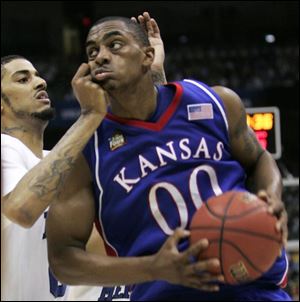
Missed free throws prove to be fatal flaw for Tigers
4/8/2008
Darrell Arthur of Kansas takes it on the chin as he tries to slip past Memphis defender Shawn Taggart. Arthur led the Jayhawks on the night with 20 points and 10 rebounds.
SAN ANTONIO Clang. Bonk. Boing.
That was the awful sound of Memphis letting the NCAA championship game rattle away at the foul line last night.
Too bad for the Tigers, they lived up to their reputation at the end a wonderful team that simply couldn t hit big free throws.
Given a chance to put away Kansas, stars Chris Douglas-Roberts and Derrick Rose made just 1-of-5 foul shots in the final 1:12 of regulation. And by the time Douglas-Roberts regained his touch in overtime, it was too late to prevent a 75-68 overtime loss.
All season long, as Rose and Douglas-Roberts dazzled with an assortment of trick shots, doubters said the Tigers inability to make a simple, 15-foot shot while standing still would cost them. Memphis made under 60 percent during the regular season, third-worst in Division I.
Coach John Calipari always laughed at that notion, claiming the Tigers would make them when it counted. Throughout the first five games of the NCAA tournament, he was right in fact, Rose and Douglas-Roberts combined to hit 20 of 23 in the semifinal romp over UCLA.
But then, with the championship trophy in sight, it all turned foul for the Tigers.
Ahead 62-58, Douglas-Roberts clanked the first shot of a one-and-one. The All-American guard got another try with 16 seconds and missed twice, still leaving Memphis with a 62-60 edge.
Rose, the sensational freshmen most likely headed to the NBA, could ve put it away when he went to the line with 10 seconds left and that same 62-60 lead. Hit twice, and it s probably over.
Instead, after playing so poised during a second-half rally, he suddenly looked like a true freshman when his first shot rattled in and out. He made the next one, but that gave Kansas enough room so that Mario Chalmers wild 3-pointer just before the buzzer sent it to overtime.
Douglas-Roberts later made two free throws, and it was little consolation by then. The Jayhawks were on their way.
Memphis finished a rickety 12-for-19 on free throws. Along with all the things Kansas did right, its foul shooting was perhaps the deciding factor at 14-for-15, the Jayhawks showed their stripes.
ON THE HIGH Cs: The Kansas and Memphis pep bands got warmed up early, commandeering a couple of passenger barges and blaring their fight songs while floating along the River Walk canal.
Each school took a boat for its band and another for the cheerleaders, and they spent an hour making loops around the downtown channel. Fans from both teams jammed pedestrian bridges, overpasses and the walkways to show their colors and playfully shout down the opposing side.
RAMBLIN PREDICTION: The last time the Final Four was in San Antonio, Georgia Tech played in the finals. This time, three Georgia Tech engineering professors are predicting the winner based on a computer ranking system they developed.
The ramblin result was: Congrats, Kansas.
Tech s system goes by the acronym LRMC, which stands for Logistic Regression Markov Chain. According to a news release, it uses basic scoreboard data: teams played, home court advantage and margin of victory.
What makes the system worth mentioning? It predicted the Final Four.